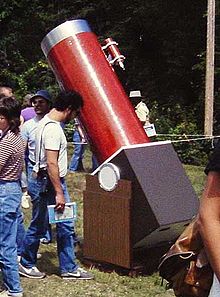Dobsonian telescope
A Dobsonian telescope is a Newtonian telescope design.

It is "altazimuth-mounted". An altazimuth or alt-azimuth mount is a simple two-axis mount. It supports and rotates an instrument about two perpendicular axes – one vertical and the other horizontal.
Rotation about the vertical axis varies the compass bearing of where the instrument points (the azimuth). Rotation about the horizontal axis varies the altitude (angle of elevation) of the pointing direction.
It was popularised by John Dobson in 1965. It increased the size of telescopes for amateur astronomers. Dobson's telescopes had a simplified mechanical design that was easy to make from readily available components. It made a large, portable, low-cost telescope.
The design works for looking at faint, deep-sky objects such as nebulae and galaxies. This type of observation needs a large objective diameter (i.e. light-gathering power) of relatively short focal length. It can be taken to less light-polluted places.[1][2]
References
change- ↑ Newton, Jack; Teece, Philip (19 January 1995). The Guide to Amateur Astronomy. p. 287. ISBN 9780521444927.
- ↑ Ferris, Timothy (8 July 2003). Seeing in the Dark. p. 39. ISBN 9780684865805.